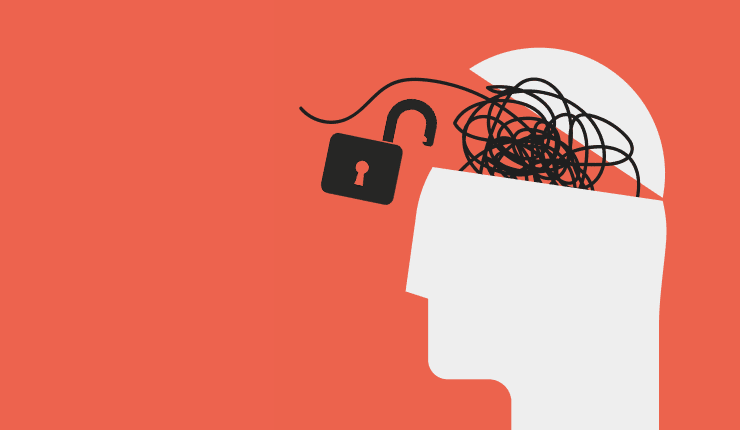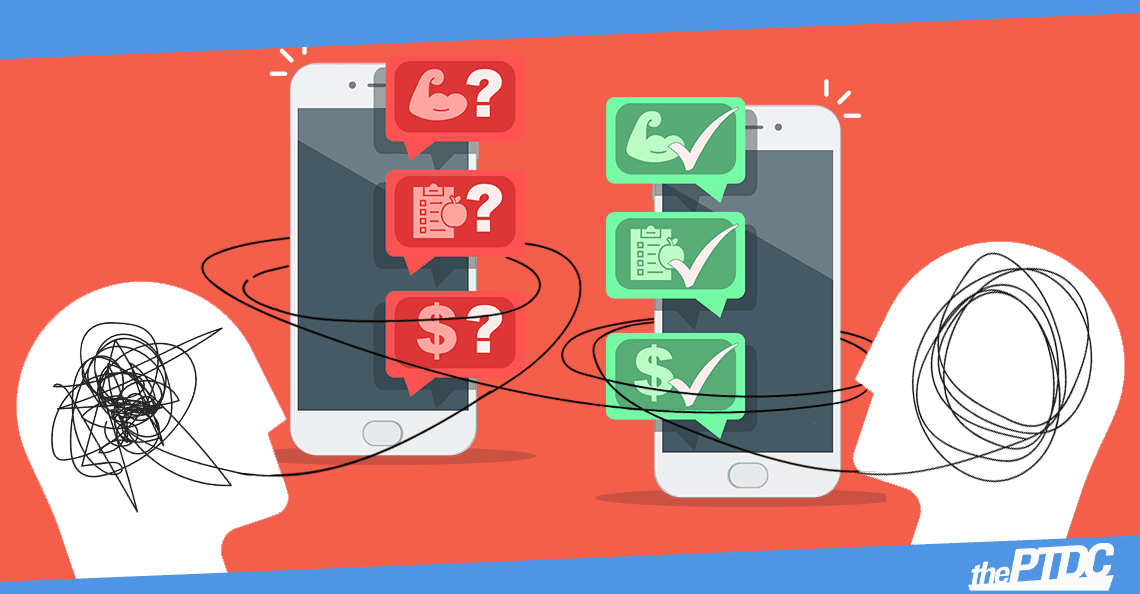I lost half my clients when gyms closed in early 2020.
What worked in the gym wasn't satisfying to my clients when we moved online.
They missed the human connection.
That’s when I figured out what was missing. And this article will share what I did that turned it all around.
Just this morning, for example, a client told me he'd lost 15 pounds since we started working together. After my early struggles with online training, this was an incredible feeling.
It didn’t happen because of my prescribed reps, sets, or exercises, or because of the magic diet plan I gave him.
It happened because we talked.
It happened because we engaged in the kind of deep, personal conversations I never had with my in-person clients for the first 10 years of my coaching career.
Most of all, it happened because I was desperate to save my business.
When I was forced online due to COVID-19, I thought I could work with my clients the same way I’d trained them in person, giving each of them an hour of my time and then moving on to the next client.
But what worked in the gym wasn’t satisfying online.
When I saw how much they just wanted to talk, I realized I was doing them a disservice by not communicating more.
Those conversations not only helped me retain those clients, they actually led to more referrals than I got before the pandemic.
Here’s the simple communication system I used with my online clients to build trust, promote behavior change, improve results, and ultimately bring in more business.
Five steps to build trust, promote behavior change, and improve results with your online clients
The following process improves adherence and accountability with your online clients.
- Unlock the client’s motivation
- Establish three-month behavioral goals
- Decide on 12 incremental changes to reach those goals
- Track adherence
- Review and reassess
Step 1: Unlock the client’s motivation
You schedule a meeting with a client to talk about their goals. They say they want to lose weight. Okay, fine. Your job now is to understand why they want to lose it.
To uncover their “why,” begin with open-ended questions:
- “What’s important about this goal?”
- “Can you tell me more about that?”
- “What would losing weight mean to you?”
Each time they give you more information, reflect back what they just said:
“So what you’re telling me is, losing weight would change Y? And if you change Y, that would also mean Z?”
When your reflective statements show understanding and empathy, your relationship with the client changes. They trust you, and in turn you begin to view the client more positively and feel more invested in helping them reach their goal.

Your client's results depend, in part, on your ability to get them to open up about the true reasons they want to achieve their goals.
Step 2: Establish three-month behavioral goals
Let’s say your client wants to lose 20 pounds. That’s their outcome goal. Now it’s time to identify the behaviors that will make it possible.
Start by asking them to envision their life 12 weeks from now. What will they be doing consistently to achieve that outcome, things they aren’t doing now?
Prompt your client to make these new behaviors as specific and quantifiable as possible. You want the client to come up with a list like this:
- Go to bed by 11 o’clock every night.
- Exercise four times per week.
- Eat out no more than twice per week.
- Eat vegetables with two out of three meals every day.
Are these all things they can start doing immediately, in week one of your program? Probably not.
If they aren’t exercising at all, for example, jumping right to four times a week could be too much, too soon. Same with going to bed every night at 11; if they regularly stay up past midnight, it’ll take some time to recalibrate their lifestyle and body clock.
That’s what you’ll do in the next step.
Step 3: Decide on 12 incremental changes to reach those goals
Now it’s time to work forward from where the client is to where they want to be. To do that, you and the client will come up with 12 incremental behavior changes—one per week.
The key to success here is for the client to be 100 percent confident they can and will make the change.
You want to go for more walks? Great! What time? Which days? Will you just go out the door and start walking, or will you drive somewhere?
You want to eat more vegetables? Awesome. What do you need to do first? Go to the store, buy something, and then figure out what to do with it? Or find a recipe, and then go to the store to get what you need?
**I know that this can sound silly to us fitness people. But this type of granularity is just what you need. Don’t risk leaving anything out. Spell it all out.
No answers are wrong. They just have to know what the answers are.
Now you need to ask two more questions:
- What has to be in place for you to be successful? For your walks, do you need to bring your sneakers to work with you? Do you have what you need to cook the vegetables?
- How can I support you? Do you want me to send reminders and prompts? Should I send along my favorite recipes?
With the plan established, and any potential obstacles addressed, schedule a weekly check-in, which I’ll explain in Step 5.
I like to do this via phone or Zoom, but you may prefer another way to do it. The medium doesn’t matter as much as the fact you connect every week.

It's not enough to make a list of behavior changes your client needs to make. You have to make sure the client has the tools they need to check those boxes.
Step 4: Track adherence using project management software
I’ve had a lot of success with Trello, a user-friendly project-management app the client can use for free. Each client has a daily list of each behavior they plan to do, with new behaviors added each week. They check off each item as they complete it, giving you a detailed account of their adherence.
Not every client loves it, though. And because it’s a new behavior, it doesn’t always stick.
If Trello doesn’t work, we switch to a Google form, which is also free and even easier to use.
I then connect the client’s behavior plan to an app called EZ Texting, and send automated reminders. I can also set up automated emails if the client prefers those.
In the example I mentioned earlier, that client’s to-do list would include both the daily tasks they’d agreed to—prepare their meals at home (unless it’s one of the days they eat out), eat vegetables at two of their three meals, exercise (if it’s on the list that day), and go to bed at 11.
How to Track Adherence
This five-minute video from author Justin Kompf shows how he uses automated texting, Google forms, and a Trello board to increase engagement and boost adherence with his online clients.
You’ll talk about the client’s adherence on your weekly check-in. This is when you reinforce the link between their weekly behavior changes and their outcome goal.
But you don’t have to stop at one weekly check-in. If I think a client is falling into a rut—and with COVID-19 imposing so many restrictions, it happens to a lot of clients—I’ll Facetime them.
The call takes just 30 seconds and has an immediate payoff. Simply knowing I care enough to check in typically gets them moving again.
Their adherence and progress, or lack thereof, will guide both of you when you review and reassess your plan.
Step 5: Review and assess
I start the weekly check-in by focusing on something positive:
- “What was the best part of your week?”
- “What are you most proud of?”
- “Where do you feel you were most successful?”
Follow up that brief review by asking what they learned and how can they use that information going forward.
The next step is to assess the program so far. If the client is consistently achieving their goals, ask how they would like to progress. Does the client want to make any adjustments, or continue with the weekly behavior changes as planned?
If the client is successfully implementing each one, you can ask if they want to move forward a little faster.
Conversely, if they’re struggling with part of the plan, you can reassess and set more realistic behavior targets. They’ll move forward a little slower, but it’s always better for your client to feel good about small wins than to feel bad about big losses.
Repeat the process each week.

Your client's progress may be faster or slower than you anticipated. That's why you need to adjust the program as you go along.
The next 12 weeks
What happens next is up to the client. Most of the time, it’ll fall into one of these categories:
- Continue to pursue the initial goal.
- Maintain what was gained or lost in the first 12 weeks.
- Pursue a new goal.
The first is the most common.
Let’s say the client came to you with the goal of losing 20 pounds, and you set up a plan to reach that benchmark in 12 weeks. But after three or four weeks, it was clear your original plan was too ambitious—too many behavior changes in too little time.
So you and the client scaled it back, and instead of losing 20 pounds they lost 10. The goal now is to lose 10 more pounds in the next 12 weeks.
But let’s say the client set out to lose 15 pounds and achieved the goal. What now? Maybe the client wants to take their new, leaner body out for a test drive and try something they couldn’t imagine doing before, like completing their first pull-up or running a 10k.
Whatever it is, you’ll set up a new 12-week program, using the same process as the original plan.
Good communication makes you an indispensable online trainer
Here’s what I think is most important for personal trainers to understand:
For most people, you’re a luxury.
Even the beginners who most need your help will eventually learn the exercises well enough to do them on their own.
Clients will pay for your services if they believe you’re the best person to help them solve a problem and reach a goal. That’s only possible if you have deep conversations to establish a genuine human connection with each client.
Once you have that connection, you can help them unlock their motivation at the beginning of the process, and then provide the accountability they need to progress toward their goals.
It’s the one part of your personal training business that can’t be automated, delegated, programmed, or outsourced.
And to your clients, it’s the best reason to keep paying for your service.










